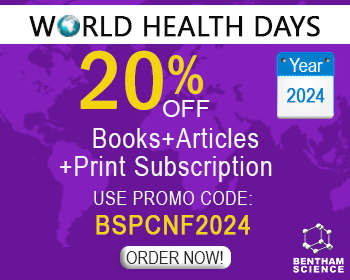Abstract
Interferon-simulated gene 15 (ISG15) belongs to the family of ubiquitin-like proteins. ISG15 acts as a cytokine and modifies proteins through ISGylation. This posttranslational modification has been associated with antiviral and immune response pathways. In addition, it is known that the genome of severe acute respiratory syndrome coronavirus 2 (SARS-CoV-2) encodes proteases critical for viral replication. Consequently, these proteases are also central in the progression of coronavirus disease 2019 (COVID-19). Interestingly, the protease SARS-CoV-2-PLpro removes ISG15 from ISGylated proteins such as IRF3 and MDA5, affecting immune and antiviral defense from the host. Here, the implications of ISG15, ISGylation, and generation of SARS-CoV-2-PLpro inhibitors in SARS-CoV-2 infection are discussed.
Keywords: COVID-19, SARS-CoV-2, SCoV-PLpro, ISG15, ISGylation, protease.
[http://dx.doi.org/10.1093/infdis/jiaa332] [PMID: 32526012]
[http://dx.doi.org/10.7416/ai.2021.2451] [PMID: 34223866]
[http://dx.doi.org/10.3390/cancers12082186] [PMID: 32764454]
[http://dx.doi.org/10.1177/19714009211029177] [PMID: 34224248]
[http://dx.doi.org/10.1007/s00702-021-02371-7] [PMID: 34223998]
[http://dx.doi.org/10.1016/j.cellsig.2021.110064] [PMID: 34146659]
[http://dx.doi.org/10.1007/s12020-021-02807-w] [PMID: 34224085]
[http://dx.doi.org/10.1016/j.cyto.2021.155430] [PMID: 33508651]
[http://dx.doi.org/10.1016/j.cell.2020.04.035] [PMID: 32413319]
[http://dx.doi.org/10.1016/j.lfs.2021.119752] [PMID: 34171382]
[http://dx.doi.org/10.1038/s41588-020-00731-9] [PMID: 33077916]
[http://dx.doi.org/10.1016/j.ygeno.2020.09.002] [PMID: 32916258]
[http://dx.doi.org/10.1186/s40364-020-00228-x] [PMID: 33005420]
[http://dx.doi.org/10.3389/fimmu.2018.00847] [PMID: 29780381]
[http://dx.doi.org/10.1371/journal.pone.0087377] [PMID: 24475282]
[http://dx.doi.org/10.4049/jimmunol.177.12.8612] [PMID: 17142760]
[http://dx.doi.org/10.1139/o04-041] [PMID: 15181474]
[http://dx.doi.org/10.1016/j.lfs.2004.01.030] [PMID: 15219805]
[http://dx.doi.org/10.1080/10623320490512156] [PMID: 15370293]
[http://dx.doi.org/10.2174/1389203721999201208200747] [PMID: 33292152]
[http://dx.doi.org/10.1038/cr.2012.133] [PMID: 22964713]
[http://dx.doi.org/10.1016/j.molcel.2017.10.003] [PMID: 29100055]
[http://dx.doi.org/10.1016/j.celrep.2020.107772] [PMID: 32553163]
[PMID: 12067988]
[http://dx.doi.org/10.1158/1535-7163.MCT-08-0753] [PMID: 19074853]
[http://dx.doi.org/10.1158/0008-5472.CAN-14-1354] [PMID: 25368022]
[http://dx.doi.org/10.18632/oncotarget.7626] [PMID: 26919245]
[http://dx.doi.org/10.1158/0008-5472.CAN-05-1123] [PMID: 16424026]
[http://dx.doi.org/10.1155/2013/570909] [PMID: 24024201]
[http://dx.doi.org/10.1136/gut.2009.194068] [PMID: 20581239]
[http://dx.doi.org/10.1038/ncomms13588] [PMID: 27882925]
[http://dx.doi.org/10.1038/onc.2012.633] [PMID: 23318454]
[http://dx.doi.org/10.1038/embor.2009.23] [PMID: 19270716]
[http://dx.doi.org/10.1016/j.yexcr.2018.03.017] [PMID: 29555370]
[http://dx.doi.org/10.18632/oncotarget.3372] [PMID: 25749047]
[http://dx.doi.org/10.1074/jbc.M208435200] [PMID: 12582176]
[http://dx.doi.org/10.1111/febs.12754] [PMID: 24533902]
[http://dx.doi.org/10.1128/JVI.02695-15] [PMID: 26763998]
[http://dx.doi.org/10.1073/pnas.0607038104] [PMID: 17227866]
[http://dx.doi.org/10.1038/ncomms11496] [PMID: 27193971]
[http://dx.doi.org/10.1126/science.1224026]
[http://dx.doi.org/10.1021/acsinfecdis.0c00168] [PMID: 32428392]
[http://dx.doi.org/10.1038/nature13801] [PMID: 25307056]
[http://dx.doi.org/10.1038/s41598-019-39343-7] [PMID: 30858391]
[http://dx.doi.org/10.1128/JVI.79.7.4550-4551.2005] [PMID: 15767458]
[http://dx.doi.org/10.1128/JVI.79.24.15199-15208.2005] [PMID: 16306591]
[http://dx.doi.org/10.1016/j.antiviral.2018.05.004] [PMID: 29753657]
[http://dx.doi.org/10.1038/s41423-020-00602-7] [PMID: 33462384]
[http://dx.doi.org/10.1038/s41586-020-2223-y] [PMID: 32272481]
[http://dx.doi.org/10.1007/s11030-020-10130-1] [PMID: 32737681]
[http://dx.doi.org/10.1128/JVI.79.24.15189-15198.2005] [PMID: 16306590]
[http://dx.doi.org/10.1038/s41564-021-00884-1] [PMID: 33727702]
[http://dx.doi.org/10.3390/v13020182] [PMID: 33530371]
[http://dx.doi.org/10.3390/ijms22083957] [PMID: 33921228]
[http://dx.doi.org/10.1021/acs.jpclett.1c00831] [PMID: 34110168]
[http://dx.doi.org/10.1101/2020.10.26.356048]
[http://dx.doi.org/10.21203/rs.3.rs-27134/v1]
[http://dx.doi.org/10.7150/ijbs.59943] [PMID: 33907518]
[http://dx.doi.org/10.1038/s41590-021-01035-8] [PMID: 34663977]
[http://dx.doi.org/10.1073/pnas.0805240105] [PMID: 18852458]
[http://dx.doi.org/10.1021/jm401712t] [PMID: 24568342]
[http://dx.doi.org/10.1128/JVI.01294-14] [PMID: 25142582]
[http://dx.doi.org/10.1038/s41586-020-2601-5] [PMID: 32726803]
[http://dx.doi.org/10.1002/jmv.26814] [PMID: 33475167]
[http://dx.doi.org/10.1016/j.crstbi.2020.12.001] [PMID: 33319212]
[http://dx.doi.org/10.1016/j.cplett.2021.138468] [PMID: 33716308]
[http://dx.doi.org/10.3390/ijms21103492] [PMID: 32429099]
[http://dx.doi.org/10.15252/embj.2020106275] [PMID: 32845033]
[http://dx.doi.org/10.4049/jimmunol.1901410] [PMID: 32169846]
[http://dx.doi.org/10.1038/mt.2015.120] [PMID: 26122932]


























